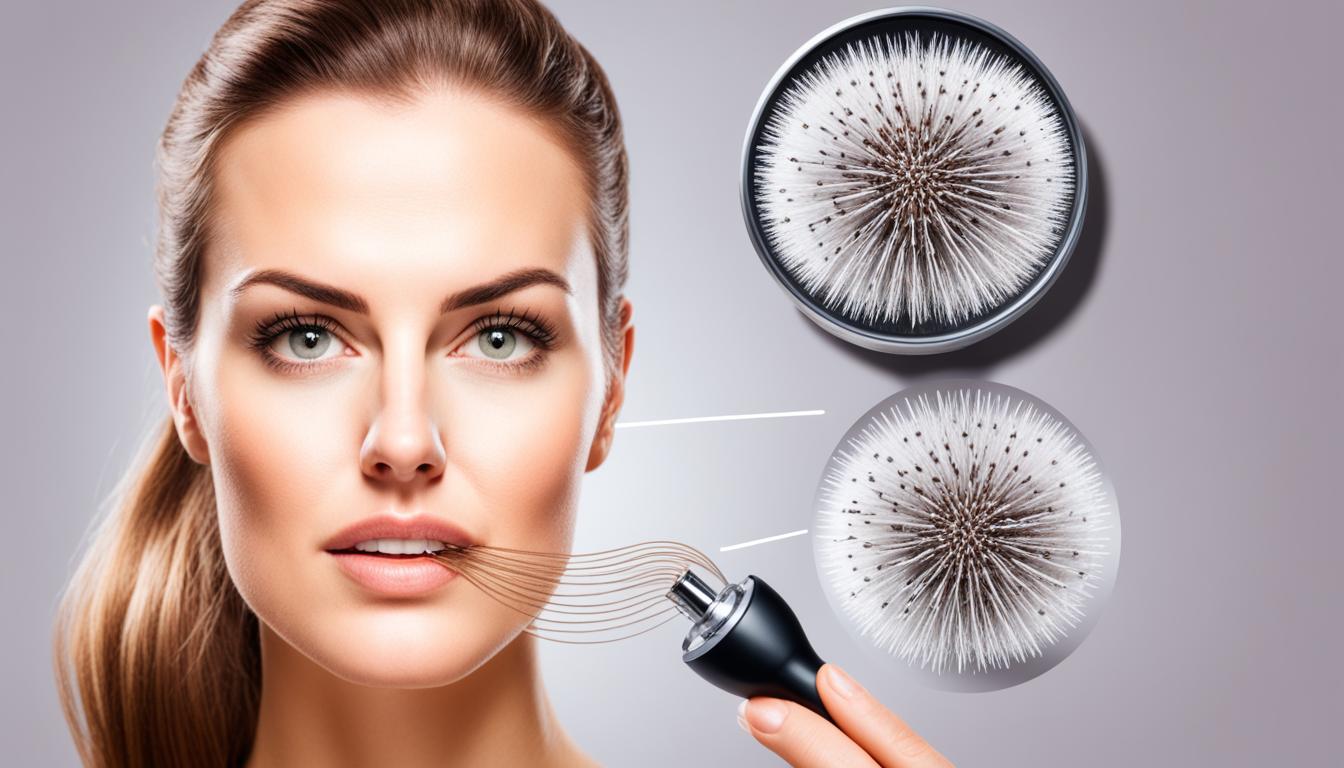Facial hair excess in women, known as hirsutism, is quite common, affecting 5 to 10% of women of reproductive age. This problem shows up as too much thick, dark, male-pattern hair on a woman’s face. It causes a lot of stress and emotional issues. The main reason behind hirsutism is too many male hormones. These can come from the ovaries or adrenals. Conditions like polycystic ovary syndrome (PCOS), certain medications, or even no clear cause might lead to it. Dealing with hirsutism needs knowing what’s causing it. Then, treatments can be tailored to each person’s needs.
Key Takeaways:
- Hirsutism is a common disorder characterized by excessive facial hair growth in women.
- Excess production of androgens, often from ovarian or adrenal sources, is the main cause.
- Polycystic ovary syndrome (PCOS) and medication use are common contributing factors.
- Diagnosis involves a thorough evaluation of medical history, physical examination, and laboratory tests.
- Treatment options include removal treatments and medication to manage hormonal imbalances.
Causes of hirsutism in women
Several things can cause women to have too much hair. Knowing these reasons is very important for treating hirsutism well. The main reason for this issue is Polycystic ovary syndrome (PCOS). It’s a disorder that affects how the ovaries work and makes too much of certain hormones. This leads to more hair where you don’t want it. Other reasons include congenital adrenal hyperplasia, ovarian tumors, adrenal tumors, Cushing’s disease, hyperthecosis, and some medications.
With PCOS, the excess androgens come from the ovaries. Androgens are one type of hormone. This causes hair follicles to overreact to these hormones, which makes hair grow more in places like the face and back.
A genetic issue can lead to too many androgens with congenital adrenal hyperplasia. It’s because the body makes the wrong amount of certain hormones. This can cause extra hair to grow.
Ovarian tumors and adrenal tumors sometimes make too many androgens as well. These growths can be cancerous or not. But often, they need to be removed.
Cushing’s disease may happen when a pituitary gland tumor makes too much cortisol. This can lead to hirsutism and other symptoms like gaining weight.
With Hyperthecosis, certain cells in the ovaries grow the wrong way and make too many androgens. It’s a tough condition to find and diagnose because it’s very rare.
Some medications can also cause hirsutism. This includes drugs like anabolic steroids and danazol, as well as some used in hormone therapy and to treat endometriosis.
Hormonal Imbalances and Excessive Hair Growth
The bottom line is that hormonal issues are at the heart of hirsutism. They mess up how hair usually grows, which shows up as too much hair in certain places. This is why understanding the root cause is key for choosing how to treat hirsutism.
Next, we’ll talk about how doctors find out what’s causing hirsutism. And, we’ll look at how it can be managed best.
Diagnosis and management of hirsutism
To make an accurate diagnosis and manage hirsutism, a full evaluation is key. It involves looking into the patient’s medical past, doing a checkup, and running some tests.
The healthcare provider will ask detailed questions about the patient’s history. They’re looking for any conditions or issues that might cause too much hair. They also note symptoms like acne or irregular periods.
A thorough physical look is also crucial. It helps spot any excess hair and checks for any signs of hormonal problems. These issues could show up on someone’s body mass index or through more masculine features.
Special blood tests are carried out to measure hormone levels. This helps find if there’s an internal disorder causing the hirsutism. For instance, high testosterone might suggest a hormonal issue.
Imaging studies can include ultrasounds to look closer at the ovaries and adrenal glands. Doctors often use this to look for tumors or other issues that might be behind the hirsutism.
After pinpointing the cause of hirsutism, the next step is talking about treatment. Managing this condition frequently needs both hair removal methods and medication for hormone issues.
Methods like electrolysis or laser hair removal can help get rid of the unwanted hair. These can offer lasting solutions and make the affected areas look better.
Doctors may also suggest medications. Anti-androgens or oral contraceptives can help keep hormone levels balanced. The right medicines will depend on the specific cause and the patient’s situation.
Overview of Diagnosis and Management of Hirsutism
| Evaluation | Management |
|---|---|
| – Detailed medical history assessment | – Removal treatments (electrolysis, laser hair removal) |
| – Physical examination | – Medication management (oral contraceptives, anti-androgens) |
| – Blood tests (testosterone, DHEA, FSH, LH) | |
| – Imaging studies (ultrasound) |
Note: The specific diagnosis and management plan for hirsutism may vary depending on the underlying cause and the individual patient’s needs. It is essential to consult with a healthcare professional for personalized guidance and treatment.
Stem cell therapy for hirsutism
Stem cell therapy is a new field in regenerative medicine. It aims to treat hirsutism, which is excessive hair growth. This method uses stem cells to repair damaged or faulty tissue and organs.
It holds potential for helping with hirsutism by regenerating hair follicles. This regeneration could restore normal hair growth. Researchers are working to grow new hair follicles with stem cells. Better results could be seen in future patients.
Research on stem cell therapy for hirsutism is just starting. It’s a hopeful path for treating the condition. But, more studies and trials are necessary to know if it’s effective and safe.
With time, stem cell therapy could change how hirsutism is managed. This could give people with hirsutism a new outlook and better life quality.

